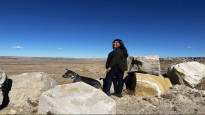HOPI RESERVATION, ARIZONA According to the folklore of the Hopi tribe, it all started with corn.
The origin story of the tribe tells how the Hopi appeared in the world and met the world’s guardian Maasawi. This gave the tribe a water kettle, a stick for tilling the soil, and corn seeds—everything the tribe would need to farm. Maasaw named the Hopi’s task of tending the land.
To Maree Mahkewa, 25, this task is particularly important as he belongs to the Maize clan of the tribe. He and other members of the clan preserve the seeds used for farming and grow corn for ceremonial needs and food for the whole tribe.
It has become more difficult every year. Young people move away from the reservation to nearby cities for work and education. of the state of Arizona the temperature has clearly risen in a hundred years and the soil dries up.
Farming needs both labor and water.
However, Mahkewa believes he knows the solution. It is found in traditional farming methods.
The Hopi Reservation is located within the Navajo Reservation in Arizona. The Hopi are believed to have arrived in the area thousands of years ago. The oldest village, 20 miles from Mahkewa’s home, was founded in the 11th century, making it the oldest permanent settlement in the entire United States.
When the United States carried out forced relocations as part of the genocide of indigenous peoples, the Hopi territory was reduced to less than a quarter of the tribe’s original land area.
However, the tribe has been allowed to stay in their ancient places of residence. The dry soil of the American Southwest has never been desirable farmland.
– We have always lived in more difficult conditions than many others who practice farming. This is one of the driest areas in the country and the work has always been difficult, says Maree Mahkewa.
Environmental sciences at university, then back to home village
Maree Mahkewa’s family has always cultivated the land. After finishing high school, he went to study environmental sciences at the University of Arizona. That’s when he began to understand that society sees his way of life as climate activism.
Unlike many young people, Mahkewa decided to return to his home village after graduation to continue his work to fight climate change and preserve traditions.
Mahkewa wanted to teach other young adults the traditional ways of cultivating the land so that they would be preserved. Now he works as a coordinator in an organization that organizes open trainings for members of all indigenous peoples. They relearn old traditional farming methods.
The Hopi’s traditional farming method has adapted to the drought. They practice permaculture, which imitates the cycle of nature through, for example, crop rotation.
The land is cultivated in turn with different plants to keep it fertile without artificial nutrients. In addition, the fields are planted sparsely so that the plants have enough water from the scarce rains.
– These methods are nothing new, they have been used for hundreds of years. We have survived with the help of them when the conditions have changed, says Mahkewa.
He believes that traditional means are the best way to adapt to current climate change as well.
– In these times, when we don’t know what changes will happen, these technologies give us the opportunity for flexibility. In this way, we can be ready for unpredictable changes, he says.
Self-sufficiency is also important in terms of food safety. There are only a couple of small grocery stores on the Hopi reservation that sell expensive processed food. Larger grocery stores with more options and fresh food are almost a two-hour drive away.
– The reserve’s grocery stores are the last straw for many. Part of our job is to show that it is possible to grow food yourself, says Mahkewa.
Traditionally, Viljelysmaat would be passed down from mother to daughter
Mahkewa’s home village is established on top of a hill, high above the surrounding valleys. From a distance, the sand-colored houses are almost difficult to distinguish from the surroundings.
The home of the Mahkewa family is a small two-story house. There are photos on the walls of that hut, where the family’s daughters are dressed in traditional costumes. In the corner of the room is a Damana doll, which the Hopi believe will bless the family with many daughters.
The Hopi tribe is maternal. Traditionally, clans were led by women, and Farmlands would be passed down from mother to daughter.
However, the tribal government organized under the influence of the US administration does not follow traditions. It is mostly run by men. Inheriting land no longer happens from mother to daughter, but permission must be sought from the administration.
– This directly affects how we see the meaning of the country. The tribal government has changed our relationship with the land and how we take care of it, says Mahkewa.
Drought and floods worsened
Still, women still play a key role in keeping traditions going. Mahkewa says that she is lucky, because despite all the difficulties, her grandparents and mother have stayed in the village.
It could have been the other way around – the tribe’s children were forcibly taken to American boarding schools. So did Mahkewa’s grandmother Evangeline Nuvayestewa. After that, he lived abroad and in other parts of the United States for a long time, but finally returned to the village to continue the traditions.
Mahkewa’s mother Marissa Nuvayestewa says that for the last few years the erosion has accelerated. In addition to the drought, flooding has worsened as the climate has become increasingly unpredictable.
– They [Mareen sukupolvi] keep us at the pace we need to be in order to respond to rapid changes, says Nuvayestewa.
